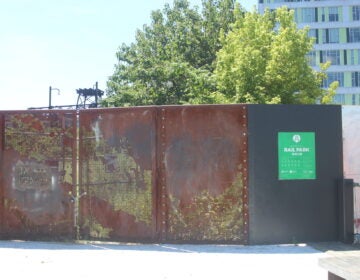Janet Echelman sheds light on Dilworth Plaza “dry mist” fountain

If City Hall is the heart of the city – the pump through which the Broad and Market street arteries flow and through which Philadelphia is mobilized by transit connections – then the art coming to Dilworth Plaza will be “like an x-ray of the city’s circulatory system unfolding.”
As part of the $55 million Dilworth Plaza makeover, world renowned artist Janet Echelman has teamed up with OLIN, Philadelphia’s premier landscape architecture firm, to develop and install an 11,600-square-foot fountain that will use color coordinated “dry mist” to trace, above ground, the movement of the subway and trolley lines below. Echelman joined OLIN designer Susan Weiler to discuss their collaboration at a PennDesign lecture this week.
Inching toward completion, Dilworth Plaza is being transformed from the hard, uninviting, multi-level terrain it once was into a single-level, accessible and, most importantly, active space. Echelman’s art will play a critical role in activating the city’s crosshairs.
The fountain will occupy a central portion of the plaza and will be on an even plane with the rest of the space. Visitors will be able to walk across the fountain’s surface thanks to its metal grate frame. Along the skeleton of the underground transportation network, ribbons of atomized air, or dry mist, will blast from the fountain. This dry mist will be colored with light projections and will follow subway trains and trolleys in real time as they pass beneath the fountain. Echelman’s hope is that users interact with the mist, touching it and redirecting it with their bodies.
While Echelman is known worldwide for her “living, breathing sculpture environments,” this project is a break from her normal work and an experiment for everyone involved.
When Weiler made the initial call, she said, “Janet, you wanna do something really, really different than you’ve ever done?” and people thought she was crazy, she recalled at the PennDesign discussion.
“Who knew what she would come up with?” Weiler said. “But I knew it would be right.”
Echelman is best known for her suspended, urban sculptures. Made out of fibers stronger than steel, these sculptures are inspired by Echelman’s early work hoisting fishing nets cast with as many as 1.5 million hand-tied knots into the air and letting them billow in the wind. Her work, which is enlivened by place, movement, color and light, has traveled the globe – from India to Bali, Portugal, Australia, Bejing and beyond.
But in Philadelphia, Echelman knew, one of her famous flying sculptures wouldn’t be appropriate. For one thing, she did not want to detract from or compete with City Hall. For another, the site lacks the open, vertical space that other sites had. Instead, Echelman found inspiration in this history of Philadelphia’s waterworks and in the role that steam power played in both the evolution of Philadelphia’s industrial prowess.
So while Philadelphia will benefit from a truly one-of-a-kind Echelman creation, Echelman is also getting a chance to spread her wings a bit.
“I don’t want to be limited,” Echelman said. “I don’t ever want to repeat the same utterance, and the space gives that opportunity.”
As her work has evolved, one thing that has surprised Echelman is how people interact with her art.
“I didn’t set out to create social space, but once I discovered this was happening, I wanted to push it and explore it,” she said.
The piece at Dilworth is a chance to push further and to explore a new avenue. That is not lost on Echelman. It takes time to develop a skill, she said, and it’s hard to get opportunities to develop a new body of work. Another city might not have given Echelman permission to experiment the way she is in Philadelphia, where with the help of OLIN, she is creating something wholly new.
Together Echelman and OLIN have built prototype after prototype of the structure, accounting for everything down to the size of stiletto heels that might walk across it. Stilettos are just the tip of the iceberg when it comes to complicating factors though.
“It really is relatively complex in terms of how it works,” Weiler said of the mechanisms behind the fountain.
Because there needs to be adequate headroom for the transportation infrastructure below ground, the mechanisms that pump air in, atomize the water and light it from below need to fit into a pocket about three feet deep. Through prototyping, OLIN perfected a system of grates that projects the dry mist as high as possible but hides these “guts,” or the inner workings.
The fountain also has to be programmed to track the movement of the subways and trolleys using real time data, something even SEPTA struggles to do. And because Center City District will take over responsibility for the fountain once it is complete, it had to be designed with maintenance constraints in mind.
Despite these complexities, the project is chugging along with the rest of the Dilworth Plaza construction. The fountain is being installed sequentially, so as Dilworth construction enters each new phase, so too does the fountain. If all goes according to plan, the plaza and the fountain will be complete this September.
WHYY is your source for fact-based, in-depth journalism and information. As a nonprofit organization, we rely on financial support from readers like you. Please give today.











